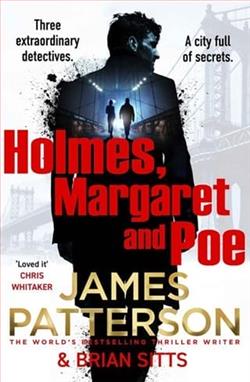Summary

Holmes, Margaret and Poe
by James Patterson
Crime! Murder! Who are you going to call?
In New York City, three intriguing, smart, and stylish private investigators open Holmes, Marple & Poe Investigations. Who are these detectives with famous names and mysterious, untraceable pasts?
Brendan Holmes—The Brain: Identifies suspects via deduction and logic.
Margaret Marple—The Eyes: Possesses powers of observation too often underestimated.
Auguste Poe—The Muscle: Chases down every lead no matter how dangerous or dark.
.
Read
Holmes, Margaret and Poe on http://kissnovel.net
Martial Peak Reviews
In the literary world, there are few names as iconic as Sherlock Holmes, Margaret Atwood, and Edgar Allan Poe. James Patterson, a master of modern thrillers, attempts an ambitious crossover in "Holmes, Margaret and Poe," where he merges the distinct atmospheres and narrative styles of these literary legends into a single, thrilling narrative. The concept is undoubtedly audacious, promising a blend of detective fiction, dystopian elements, and gothic horror. The execution, however, falls into a complex terrain that both fascinates and falters, offering a mixed bag of innovation and clutter.
The novel kicks off with a compelling premise: Sherlock Holmes, the quintessential detective, receives a mysterious letter that draws him into the macabre world of Edgar Allan Poe's creations. Meanwhile, Margaret Atwood, reimagined as a dystopian novelist in the Victorian era, discovers a series of letters that suggest her narratives might be more than fiction. The plot thickens as these characters, separated by disparate literary worlds and timelines, begin to see their stories converge around a series of inexplicable events that challenge their understanding of reality and fiction.
Patterson's skill in driving a fast-paced, engaging plot is evident as he weaves these three narrative strands into a cohesive story. The transitions between Holmes’s sharp, observational prowess, Poe’s dark, eerie mysteries, and Atwood's speculative, cautionary tales are crafted with a keen eye for detail. However, this weaving sometimes feels more like a collision than a seamless integration. The stark differences in each author's style and thematic concerns can make the narrative feel disjointed, leaving the reader to grapple with abrupt shifts in tone and setting.
Characterization is one of the novel's stronger points. Patterson pays homage to the original spirit of Holmes and Poe’s characters while adding layers that show them wrestling with scenarios they could never have encountered in their original stories. Sherlock Holmes interacts with the gothic elements of Poe’s world with a skeptical eye, providing a fresh perspective on the supernatural elements that typically go unquestioned in Poe's stories. However, the reinvention of Margaret Atwood as a character in her own right rather than as an author does raise questions. It is an interesting choice but risks alienating readers familiar with the real Atwood's thematic focuses and narrative style. Patterson’s Atwood sometimes aligns surprisingly well with the imagined worlds she’s thrust into, while at other moments, she seems artificially fitted into scenarios to serve the plot’s needs.
The dialogue within the book deserves a special mention. Patterson manages to capture the distinctive voices of the characters effectively. Holmes’s dialogues are crisp and precise, imbued with a logical sharpness that fans of Conan Doyle’s work will appreciate. Poe’s contributions maintain a melancholic and oftentimes cryptic tone, fitting his dark themes perfectly. Conversations involving Atwood are laden with the philosophical undertones characteristic of her speculative fiction, although at times they can seem slightly preachy or out of context given the Victorian settings.
The settings in "Holmes, Margaret and Poe" are vividly described, from the foggy, cobblestoned streets of London to the oppressive, imagined landscapes of Atwood's dystopian visions. Poe’s eerie spirit is invoked through Gothic architectures and an overarching sense of doom that permeates his sections of the novel. Here Patterson excels, creating immersive atmospheres that serve as a backdrop for the unfolding drama.
Themes of reality versus fiction, the constraints of time, and the nature of authorial influence resonate throughout the novel. However, the exploration of these themes often feels surface-level, overshadowed by the elaborate plot twists and the novel’s ambitious structural complexity. The climax, involving a convergence of the three narratives into a single, universe-altering revelation, is both bold and a bit overwrought, leaving the reader with mixed feelings about the plausibility and impact of the resolution.
In conclusion, "Holmes, Margaret and Poe" by James Patterson is an experiment in genre-bending and narrative fusion that shows both audacity and respect for the literary giants it involves. While the novel scores points for creativity and the sheer boldness of its premise, its execution is not without flaws. Readers who are purists of the original works might find it disconcerting or unfaithful, while those with a taste for the unconventional might find it a fascinating, though at times confusing, ride. This novel is recommended for readers looking for something different, those who enjoy reimaginations of classic characters, and fans of Patterson’s usually gripping storytelling. However, it might require a willing suspension of disbelief and an appetite for narrative complexity that not all will find rewarding.
























Reviews 0
Post a Reviews: